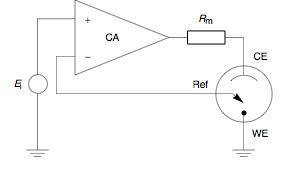 | ||
A potentiostat is the electronic hardware required to control a three electrode cell and run most electroanalytical experiments. A Bipotentiostat and polypotentiostat are potentiostats capable of controlling two working electrodes and more than two working electrodes, respectively.
Contents
The system functions by maintaining the potential of the working electrode at a constant level with respect to the reference electrode by adjusting the current at an auxiliary electrode. It consists of an electric circuit which is usually described in terms of simple op amps.
Primary use
This equipment is fundamental to modern electrochemical studies using three electrode systems for investigations of reaction mechanisms related to redox chemistry and other chemical phenomena. The dimensions of the resulting data depend on the experiment. In voltammetry, electric current in amps is plotted against electric potential in voltage. In a bulk electrolysis total coulombs passed (total electric charge) is plotted against time in seconds even though the experiment measures electric current (amperes) over time. This is done to show that the experiment is approaching an expected number of coulombs.
Most early potentiostats could function independently, providing data output through a physical data trace. Modern potentiostats are designed to interface with a personal computer and operate through a dedicated software package. The automated software allows the user rapidly to shift between experiments and experimental conditions. The computer allows data to be stored and analyzed more effectively, rapidly, and accurately than historic methods.
Basic relationships
A potentiostat is a control and measuring device. It comprises an electric circuit which controls the potential across the cell by sensing changes in its resistance, varying accordingly the current supplied to the system: a higher resistance will result in a decreased current, while a lower resistance will result in an increased current, in order to keep the voltage constant as described by Ohm's law.
As a result, the variable system resistance and the controlled current are inversely proportional
Principles of Operation
Since 1942, when Hickling built the first three electrode potentiostat, substantial progress has been made to improve the instrument. Hickling's device used a third electrode, the reference electrode to control the cell potential automatically. Up until the present day his principle has remained in use. At a glance, a potentiostat measures the potential difference between the working and the reference electrode, applies the current through the counter electrode and measures the current as an
The control amplifier (CA) is responsible for maintaining the voltage between the reference and the working electrode as closely as possible to the voltage of the input source
Prior to observing the following equations, one may note that, from an electrical point of view, the electrochemical cell and the current measurement resistor
The role of the control amplifier is to amplify the potential difference between the positive (or noninverting) input and the negative (or inverting) input. This may be translated mathematically into the following equation:
where
and
Combining Eqs. (2) and (3) yields Eq. (4):
where
Combining Eqs. (1) and (4) yields Eq. (6):
When the quantity
Eq. (7) proves that the control amplifier works to keep the voltage between the reference and the working close to the input source voltage.
Significant features
In electrochemical experiments the electrodes are the pieces of equipment that comes in immediate contact with the analyte. For this reason the electrodes are very important for determining the experimental result. The electrode surface may or may not catalyze chemical reactions. The size of the electrodes affects the magnitude of the currents passed which can affect signal to noise. But electrodes are not the only limiting factor for electrochemical experiments, the potentiostat also has a limited range of operation. The following are a few significant features that vary between instruments.
